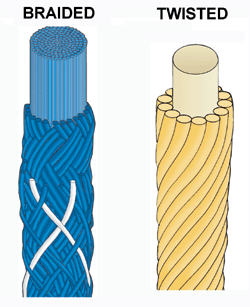|
|

How to Keep Control and Still Come up Swinging
By Steve Crandall
Vice President, Sales & Marketing
Ashaway Racket Strings

String jackets are either braided or twisted. Some strings, like Ashaway's SuperNick XL Pro squash string (left), have two jackets, one braided over the other. The outer jacket is an "open" braid with spaces between the fibers to allow more bite and give you more control. |
In my last column (February 05), we looked at how string gauge, tension, material and construction method influence racket power. This time, we'll discuss the flip side of this issue, which is how these same factors influence control.
First, let's define what we mean by control. It's not your ability to refrain from assaulting your opponent when he or she scores an easy point, nor your ability to refrain from wagging your fingers over your nose when you score an easy point. Rather, we're talking about two basic things: your ability to place a shot where you want, and your ability to affect where the ball goes after it hits the wall. The first is a function of what physicists call "the angle of refraction," and the second is a function of spin, or "English" as they say in billiards.
Second, let's be clear that the single largest determinant of both these things is you. Your skill level, power and acumen, how you address the ball, how you swing and follow through - all the fundamentals - are vastly more important than any single equipment issue. What the right equipment, and string in particular, can do is enhance these abilities, give you that little extra edge that may just make the difference.
For control, the old rule of thumb says: string thick and string tight. While the trampoline effect of thinner, looser strings generates greater "bounce" or power, a flatter, stiffer string bed helps control that angle of refraction and aids in ball placement. This is basically true, but of course, it's not really all that simple. For example, how does a stiff, flat string bed help generate spin?
Let's look at the physics - actually, a really dumbed-down version, which is all I can understand. Imagine your racket face as perfectly flat, perfectly stiff, and for the moment, perfectly still. Now imagine a ball with no spin, striking it at a perfect 90 degree angle: it would bounce back at exactly the same angle and exactly the same lack of spin. Change the strike angle thirty degrees to the left, and the ball rebounds thirty degrees to the right. This is what happens when light strikes a mirror and why physicists say the angle of incidence equals the angle of refraction.
Put the racket in motion and you change the equation, but not the basic principles. Now what happens is that these forces combine and the angle of refraction is determined mathematically by what physicists call "vector analysis." Our brains do these calculations automatically and with tremendous precision, while our bodies execute them with varying degrees of skill. But what our brains are trying to make us do is control that angle of refraction so that the ball goes exactly where we want it to. A perfectly flat, perfectly stiff string bed helps the brain do this.
Now factor in spin so we can try to control what the ball does after it hits the wall. To create spin, the racket face must slice laterally across the direction of the ball at the moment of impact. This again changes the vector/refraction equation and requires that the string be able to grip or "bite" the ball in order to: 1) eliminate any existing spin, and 2) to impart that precise degree of new spin which our brains clearly inform us will rebound the ball totally out of our opponent's reach... If only we can hit it right.
So here's where things get a bit muddy and where personal preference, skill and playing style should influence string choice. As a general rule, thin strings generate more bite than thick, and if you are really a finesse player, the combination of improved power and bite from a thin, multifilament string may give you better overall control than a thicker, stiffer string.
But the real secret to increasing bite lies in the string jacket. The jackets of almost all squash strings are made of nylon, which is either braided or twisted over the core. Twisting creates a smooth surface, while braiding produces a more textured surface, enhancing ball control (and increasing durability). Some strings, like Ashaway's SuperNick® XL, have two jackets, one braided over the other. The outer jacket is an "open" braid with spaces between the fibers to allow more bite and give you more control.
Check the manufacturer's specs and try different combinations of both string type and tension. You might even want to keep a log to help analyze your reaction to each and help identify the right degree of power and control to optimize your style of play
This article previously appeared in Squash Magazine.
|